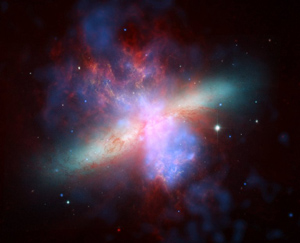The Wide Field Infrared Survey Explorer (WISE) is an astronomy blogger’s gift that keeps on giving. Observing huge swaths of the sky in the infrared, it sends back the coolest images! Behold:
Yeah, click that to get the most cromulently embiggened 4000 x 4000 pixel version.
Those two galaxies are M82 (top) and M81 (bottom), and are both about 12 million light years away, relatively nearby as these things go. They are the two biggest galaxies in the M81 group, a collection of galaxies much like our own Local Group (dominated by our galaxy, the Milky Way, and Andromeda). M81 and M82 are almost certainly interacting with each, having had at least one pass sometime in the past, and may eventually merge in a billion years or so. Maybe less. Currently, they’re roughly 300,000 light years apart.
WISE sees them in the infrared, and in this picture blue represents the infrared wavelength of 3.4 microns, cyan is 4.6 microns, green is 12 microns, and red is 22 microns. For comparison, the reddest red your eyes can see is less than 1 micron, so these are well out into the IR.
 Obviously, M81 looks very different than M82! M81 is a classic grand design spiral, roughly the same size or a bit smaller than the Milky Way. Most of the light you see comes from stars, which are bright at the shorter IR wavelengths.
Obviously, M81 looks very different than M82! M81 is a classic grand design spiral, roughly the same size or a bit smaller than the Milky Way. Most of the light you see comes from stars, which are bright at the shorter IR wavelengths.
M82, on the other hand, is a mess. I’ve included an image that’s a composite from Hubble (visible light), Chandra (X-rays), and Spitzer (IR). In visible light, M82 is cigar-shaped, but in X-ray and IR you can see all that schmutz coming out of it. It used to be thought that this was an exploding galaxy; that is, a series of exploding stars in the center caused this. However, it’s understood now that M82 is a starburst galaxy, undergoing a paroxysm of star birth. All that stuff is actually gas and dust blowing out of the galaxy due to the combined winds of the stars forming there.
In the WISE image, that warm dust is the dominant feature of the galaxy! A lot of it is comprised of PAHs – polycyclic aromatic hydrocarbons, complex organic molecules common in space. It’s not too bad to think of it as soot, or smoke… coming from a cigar-shaped galaxy. Hmmm.
Most likely, this burst of star formation was caused by M81’s close pass to M82. But then, why did M82 go all space-kablooie and M81 wound up all wound up? Perhaps it’s because M81 is more massive and bigger than M82, so it could hold its shape better. In a few hundred million years, when they pass again, I’m sure we’ll know more.
One thing to keep in mind about these galaxies is that they are visible using binoculars from a moderately dark site. I’ve seen ‘em myself. And some people have been documented as being able to see them with their unaided eyes, which is pretty amazing! The farthest object I’ve seen with my unaided eyes is Andromeda, which is about 2.5 million light years away, so clearly some folks have better eyes than I do.
But then, when we have WISE, Hubble, Chandra, Spitzer, and all the others, it’s really humanity’s eyes that see so far.
Image credit: NASA/JPL-Caltech/UCLA; NASA/ESA/CXC/JPL-Caltech
Related posts:
- Two nearby galaxies peek out through the dust
- Not all haloes are created equal
- AAS #6: Lonely stars between galaxies
- M81 up close and personal
- M82 stifles a cosmic belch
- Giant airplane-mounted telescopes sees first light